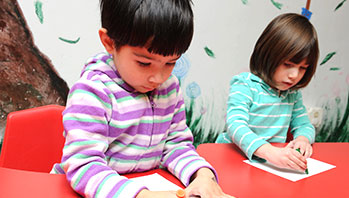- colored yarn and ribbons
- crayons and markers
- felt and other fabric swatches
- glue
- googly eyes
- poster paper
- family
- special
MA Standards:
Writing: W.PK.MA.2: Use a combination of dictating and drawing to explain information about a topic.
Social Emotional/Family 6.1: Describe different types of families, addressing membership and social influences, and the functions of family members.
Head Start Outcomes:
Reasoning/Problem Solving/Symbolic Representation 1: Represents people, places, or things through drawings, movement, and three-dimensional objects.
PreK Learning Guidelines:
English Language Arts 2: Participate actively in discussions, listen to the ideas of others, and ask and answer relevant questions.
Health Education 20: Describe members of their family and discuss what parents do for their children to keep them safe and healthy.
Draw and Write Together: Someone Special

© Commonwealth of Massachusetts, Department of Early Education and Care (Jennifer Waddell photographer). All rights reserved.
Help children create a picture of a special person in their family who loves them. Explain that a special person is someone who is very important to them. As children begin working, ask questions such as:
- Tell me about someone in your family who loves you and is very important, or special, to you.
- Why is he or she a special person to you?
- What does this special person do to show you he or she loves you?
Have children think about and draw a picture of that person. Prompt them to use the materials to add details to their drawing if they would like, such as googly eyes, fabric shirt, etc.
- Then encourage children to dictate or write a label on their portrait with the person’s name and what relation they are to the child (e.g., Mommy, Daddy, my cousin, Grandma). Include the pictures on the “Our Families” wall.
English Language Learners: Using visual supports such as a photograph or illustrations, review vocabulary associated with families. Have children say the words in their first language and have others repeat. (brother, sister, mother, father, etc.)
Adaptation: For groups with young children, you may want to give them a sheet with an outline of a person and have them add the details.
